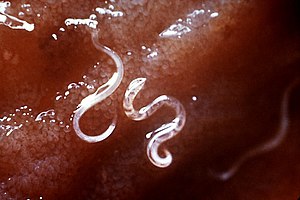Ancylostoma caninum
| Ancylostoma caninum | ||||||||||||
|---|---|---|---|---|---|---|---|---|---|---|---|---|

Ancylostoma caninum on the intestinal mucosa |
||||||||||||
| Systematics | ||||||||||||
|
||||||||||||
| Scientific name | ||||||||||||
| Ancylostoma caninum | ||||||||||||
| ( Ercolani , 1859) |
Ancylostoma caninum is an especially among dogs occurring hookworm . As a parasite, it colonizes the intestines of animals and is highly pathogenic for dogs. The dog hookworm is also pathogenic for humans; it canpenetrateas larva migrans cutanea through the skin when walking barefoot on floors contaminated with dog excrement. Occasionally the parasite is also found in cats, but Ancylostoma tubaeforme is much more common in them.
Adult worms are 5 to 15 mm long and have a hook-shaped front end. The large oral capsule has cutting plates. The thin-shelled oval eggs are about 65 × 40 µm in size and have 4 to 16 furrow stages when they are laid. The larvae hatch after about 5 to 8 days. The prepatency period is two to four weeks.
In puppies, infection often occurs through breast milk (lactogenic). The infectious larvae can also penetrate through the skin or be ingested orally. Paratenic hosts such as rodents can also play a role as carriers in peroral uptake .
The infestation causes anemia , emaciation and often bloody diarrhea in dogs . Pneumonia ( bronchopneumonia ) and skin changes can also occur.
The control of adult worms is carried out with active substances against roundworms ( wormer treatment ) such as avermectins , emodepside , febantel , fenbendazole or flubendazole .
See also
literature
- Josef Boch (founder), Thomas Schnieder (ed.): Veterinary Parasitology. 6th edition Paul Parey, Stuttgart 2006, ISBN 3-8304-4135-5 .
